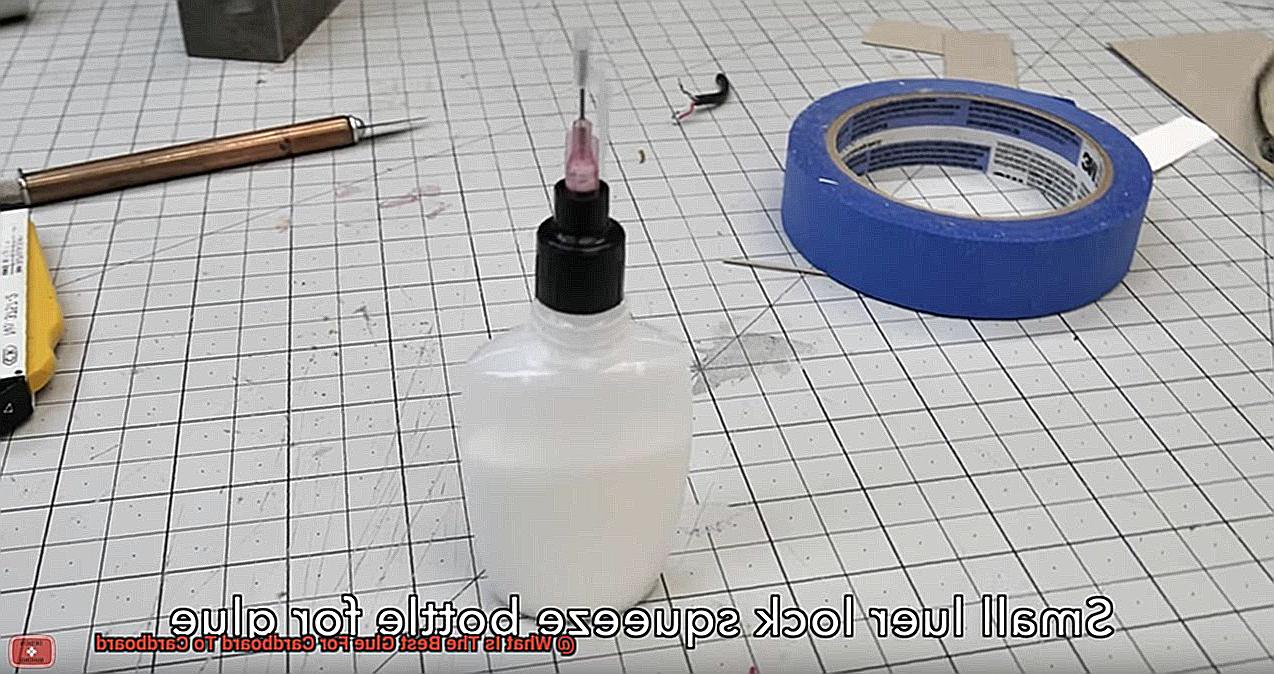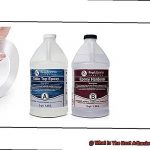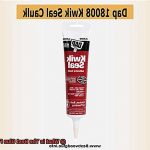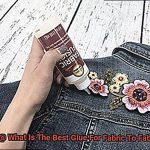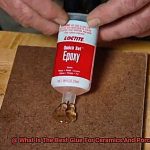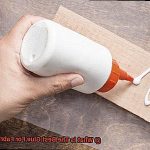Are you on the hunt for the ultimate glue to bring your cardboard creations to life? Look no further. I’m here to help you navigate through the adhesive chaos and find the perfect glue for all your cardboard-to-cardboard needs.
Let’s start with a classic: PVA glue. Also known as white school glue or wood glue, this versatile adhesive is both reliable and budget-friendly. Its thick consistency makes it ideal for bonding porous materials like cardboard, ensuring a sturdy connection every time.
If you’re in need of speed and strength, hot glue is your go-to. With its quick-setting properties, hot glue forms a strong bond in no time, allowing you to handle your project immediately. Perfect for larger pieces of cardboard or heavy-duty projects that require some extra oomph.
For those who prioritize eco-friendliness, water-based adhesives are a fantastic choice. Non-toxic, odorless, and safe for kids, these glues offer a reliable hold while keeping things neat and tidy. Plus, many dry transparently so that your masterpiece can shine through without any unsightly residue.
But what if you need something more hardcore? Enter epoxy adhesives. These two-part glues consist of a resin and a hardener that combine to create an ultra-durable and waterproof bond. While not as commonly used for cardboard projects, epoxy is perfect when you need that extra strength or when moisture might be an issue.
Now armed with this adhesive knowledge, go forth and conquer your cardboard crafts with confidence. Remember to consider factors like project size, purpose, and required durability when making your decision. Happy crafting.
Factors to Consider when Choosing Glue for Cardboard
Contents
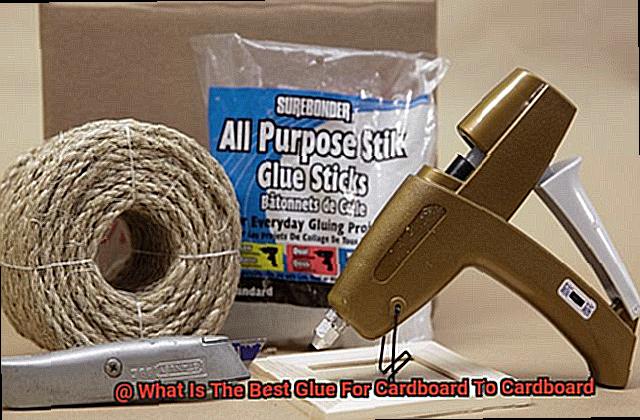
When it comes to choosing the right glue for cardboard, there are several factors to consider. The bond strength, drying time, application method, ease of use, flexibility, non-toxicity, waterproof properties, and cost all play a role in determining which glue is best suited for your project.
- Bond Strength: Cardboard is porous and requires a strong adhesive to ensure a durable and long-lasting bond. Look for glues that specifically mention their suitability for bonding cardboard.
- Drying Time: Depending on your project’s requirements, you may need a fast-drying adhesive to speed up the assembly process or a slower-drying glue that allows for adjustments and alignment.
- Application Method: Consider the nature of your project and choose a glue that offers an application method suitable for your needs. Brush applicators provide better control for intricate work, while spray glues are ideal for larger surface areas.
- Ease of Use: Choose a glue that is easy to use, especially if you have limited experience or are working with children. Look for clear instructions and user-friendly formulas. Water-based glues are often easier to clean up.
- Flexibility: Cardboard can bend and flex, so it’s important to choose a glue that offers flexibility once dried. This will prevent the bond from becoming brittle or cracking over time.
- Non-Toxicity: If your project involves children or sensitive individuals, opt for a non-toxic and safe glue. Look for labels indicating non-toxic or child-safe formulas.
- Waterproof Properties: Consider whether you need a waterproof glue for your cardboard project. Waterproof glues ensure that the bond remains intact even when exposed to moisture.
- Cost: While affordability is important, it’s crucial to balance cost with quality. Invest in a glue that offers good value for money and provides a strong bond.
White Craft Glue (PVA)
White Craft Glue (PVA), also known as polyvinyl acetate glue, is a versatile and highly effective adhesive commonly used for various crafting projects. Specifically, it is an excellent choice for gluing cardboard to cardboard due to its unique properties. Let’s explore the pros and cons of using white craft glue for this purpose.
Firstly, one of the major advantages of white craft glue is its versatility. It can be used for a wide range of crafting projects and is particularly well-suited for bonding porous surfaces like cardboard. The glue has the ability to penetrate and bond with the fibers of the material, ensuring a strong and reliable hold.
Moreover, when applied correctly, white craft glue provides a remarkably strong bond between cardboard pieces. To achieve optimal results, it is important to apply the glue evenly and in a thin layer. Using a brush or spreader will help ensure even distribution. Additionally, firmly pressing the pieces together while the glue dries enhances the bond even further.
Another noteworthy benefit of white craft glue is that it dries clear. This means that any excess glue that may squeeze out from between the cardboard pieces will not be visible once it dries. Consequently, this results in a cleaner and more aesthetically pleasing finish.
In terms of usability, white craft glue is incredibly user-friendly. It is water-based, making it easy to work with and clean up. The glue can be applied effortlessly using a brush or spreader, and any spills or excess glue can be easily wiped away with water before it dries.
However, there are a few limitations to consider when using white craft glue for cardboard projects. Firstly, although it provides a strong bond for most applications, it may not be suitable for projects requiring extreme strength or durability. For heavy-duty tasks, other adhesives such as epoxy or wood glue might be more appropriate.
Additionally, it is important to note that white craft glue is not waterproof. When exposed to water, it tends to soften, which can weaken the bond between the cardboard pieces. Therefore, for projects involving moisture or high humidity levels, it may be necessary to opt for waterproof or moisture-resistant adhesives instead.
Lastly, white craft glue typically has a longer drying time compared to certain other adhesives. This can be a disadvantage if you are working on time-sensitive projects or if you need to align multiple pieces precisely.
Hot Glue
Hot glue, a thermoplastic adhesive that is melted in a hot glue gun, is a popular choice for bonding cardboard due to its quick drying time and versatility. This adhesive option offers several advantages and disadvantages that are worth considering.
Advantages:
- Quick drying time: Unlike other adhesives that take hours to fully cure, hot glue sets within seconds. This rapid drying time allows you to keep working on your project without much waiting around. It is perfect for those tight deadlines when immediate results are needed.
- Versatility: Hot glue is not limited to bonding cardboard alone. It can adhere to a wide range of materials such as fabric, wood, plastic, and more. Its versatility makes it an excellent choice for various crafting applications beyond just cardboard bonding.
- Easy application: Applying hot glue is a breeze with a hot glue gun. The gun allows for precise control and effortless application to the desired areas. If you need to make adjustments or remove the glue, it is easily reheated and peeled off.
Disadvantages:
- Limited durability: While hot glue provides a strong bond, it may not hold up under heavy stress or weight over time. For projects that require extra strength or long-lasting durability, other adhesive options like epoxy or construction adhesive might be more suitable.
- Temperature sensitivity: When using hot glue on cardboard, temperature selection is crucial. High temperatures can cause the cardboard to melt or warp, leading to an unsatisfactory bond. To avoid this issue, it is recommended to use the low temperature setting on your hot glue gun for cardboard projects.
- Limited water resistance: Hot glue is not waterproof, making it less suitable for projects exposed to water or moisture. If you need to bond cardboard in wet environments or require water resistance, it is best to explore alternative adhesive options.
Epoxy Adhesive
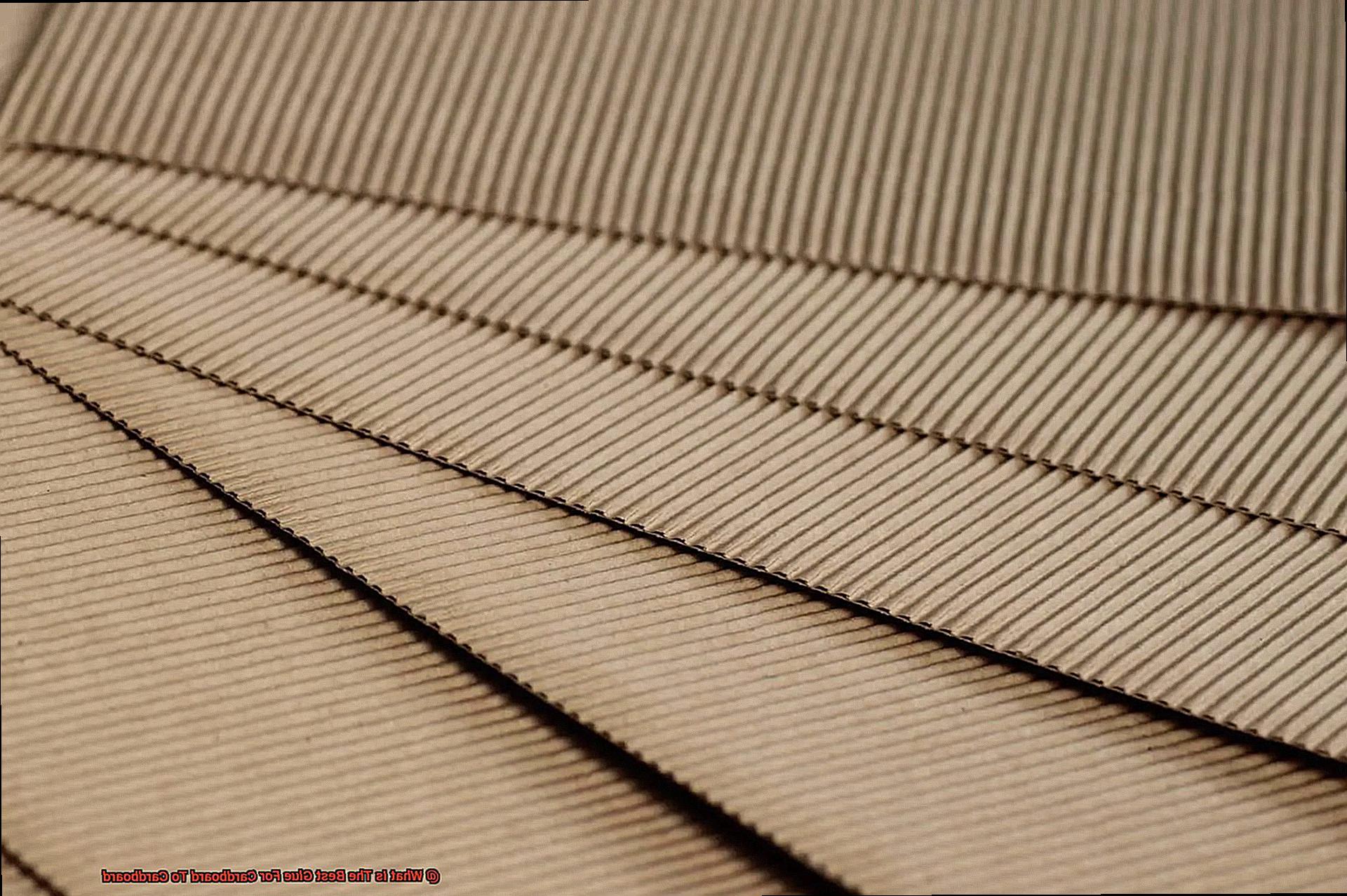
Epoxy adhesive, a popular choice for bonding cardboard to cardboard, is a powerful adhesive that forms a strong and durable bond. It offers several advantages and considerations that make it an ideal option for this application.
Advantages of using epoxy adhesive for bonding cardboard to cardboard include its strong bond, versatility, and resistance to environmental factors. Epoxy adhesive ensures that the bonded cardboard remains intact, even under heavy stress or harsh conditions. It can also bond different types of materials, making it suitable for various applications. Additionally, epoxy adhesive offers good resistance to heat, moisture, and chemicals, making it suitable for projects that may be exposed to different environmental conditions.
Considerations when using epoxy adhesive for bonding cardboard to cardboard include the mixing ratio, application and curing time, and messy application. Epoxy adhesive consists of two components – a resin and a hardener – and it is crucial to mix them in the correct ratio as instructed by the manufacturer to ensure a strong bond. Proper application involves evenly spreading the adhesive onto the surface of the cardboard and pressing the two pieces firmly together until the epoxy cures completely. It is important to note that epoxy adhesive can be messy to work with and may require wearing gloves and working in a well-ventilated area.
Super Glue (Cyanoacrylate Adhesive)
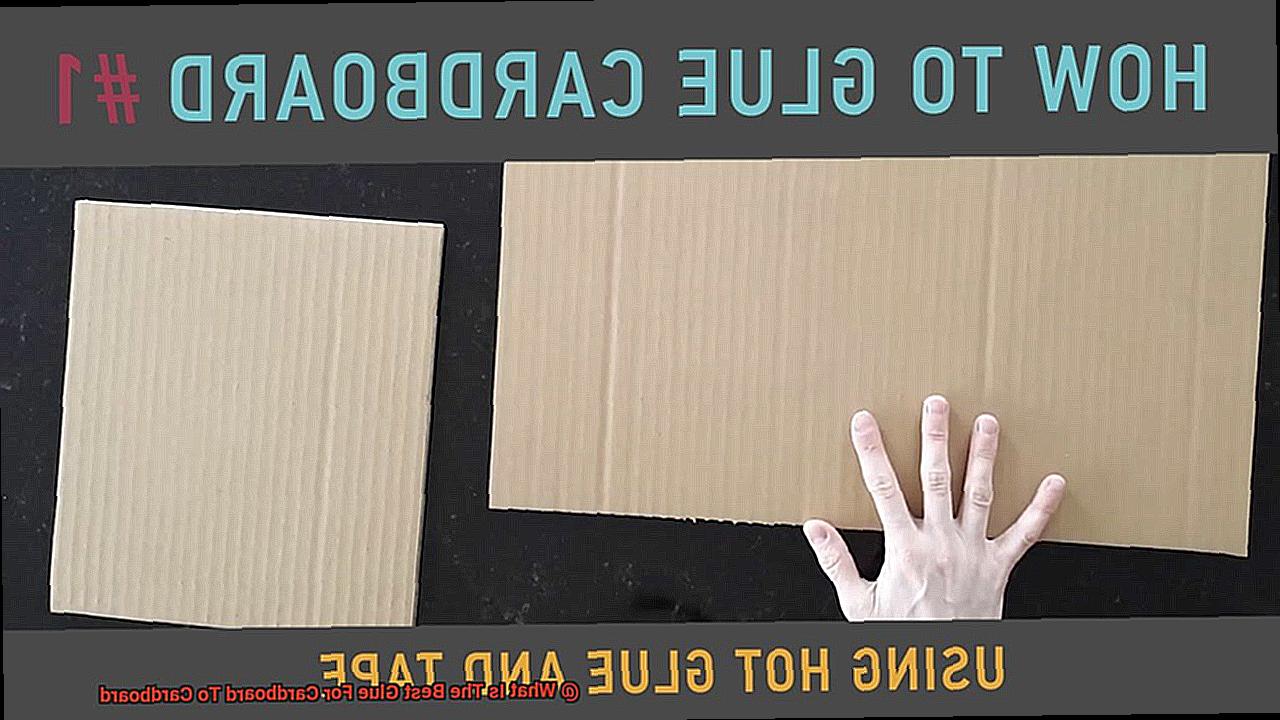
Super Glue, also known as Cyanoacrylate Adhesive, is a remarkable adhesive that has gained popularity for its versatility and fast-drying properties. It is particularly effective in bonding cardboard pieces together, making it a top choice for DIY projects and repairs.
What sets Super Glue apart is its ability to penetrate the porous surface of cardboard, creating a bond that can withstand regular handling and stress. To ensure optimal results, it is crucial to prepare the surfaces by thoroughly cleaning them and removing any dust or grease. A quick wipe with a damp cloth followed by thorough drying should do the trick.
When applying Super Glue, it is best to spread it in thin layers, ensuring even coverage on both surfaces being bonded. This technique promotes a strong and durable bond, securing the cardboard pieces firmly together. Furthermore, Super Glue sets rapidly, often within mere seconds or minutes, depending on the specific product and environmental conditions. This swift setting time allows for efficient and time-saving bonding of cardboard pieces.
However, it is important to note that while Super Glue excels in lightweight applications or temporary fixes on cardboard, it may not be suitable for all projects. For heavier or more permanent bonding needs, alternative adhesive options may be more appropriate.
Choosing the Right Glue for Your Project
Choosing the right glue for your project is crucial to ensure a successful outcome. Here are some key factors to consider when selecting the best glue:
- Material: Consider the materials you are working with and choose a glue that is compatible with them. Different glues work better on certain surfaces, such as wood, metal, plastic, or fabric. Check the label or product description to ensure it is suitable for your specific project.
- Strength: Determine the strength requirements of your project. If you need a strong bond that can withstand heavy loads or stress, opt for a stronger adhesive like epoxy or construction adhesive. For lighter projects, a general-purpose glue may suffice.
- Drying Time: Consider the drying time of the glue. Some glues dry quickly, allowing you to move on with your project faster. Others may take longer to set, providing more time for adjustments and positioning. Consider your project timeline and choose a glue that aligns with it.
- Application Method: Think about how you plan to apply the glue. Squeeze bottles or tubes allow for precise application, while brushes or spreaders may offer more control over the amount of glue used. Choose an application method that suits your project needs.
- Specific Requirements: Take into account any specific requirements of your project. If your project will be exposed to water or moisture, opt for a water-resistant or waterproof glue. If extreme temperatures or humidity are involved, choose a glue that can withstand these conditions.
- Recommendations and Reviews: Seek out recommendations from other crafters or DIY enthusiasts who have experience with similar projects. Their insights can provide valuable information about which glues work best for specific applications.
Tips and Techniques for Successful Bonding of Cardboard
Surface Preparation
Before applying any adhesive, it is crucial to ensure that the surfaces of the cardboard are clean and free from dust, grease, or any other contaminants. Wiping the surfaces with a clean cloth or using a mild detergent solution can help remove any dirt or residue that may interfere with the bonding process. Proper surface preparation creates a clean canvas for the adhesive to adhere to and ensures a strong bond between the cardboard pieces.
Choosing the Right Glue
The choice of adhesive plays a significant role in achieving a successful bond between cardboard pieces. There are several types of glue that work well for bonding cardboard, including white glue (also known as PVA glue), hot glue, and epoxy glue. White glue is a popular choice as it is readily available, easy to use, and provides a strong bond when applied properly. Hot glue is another option that works well for bonding cardboard quickly, but it may not provide as strong of a bond as white glue or epoxy glue. Choosing the right glue for your specific project ensures that you have the necessary strength and durability for your bonded cardboard.
Application Technique
When applying the chosen adhesive, it is important to apply an even layer across the surface of the cardboard pieces to be bonded. Using a brush or a small applicator can help ensure precise application and minimize excess glue. It is also essential to apply enough adhesive without overdoing it, as applying too little may result in a weak bond, while applying too much can cause excessive mess and extended drying time. Applying the adhesive evenly and in the right amount ensures consistent coverage and a strong bond between the cardboard pieces.
Clamping or Weighting
To achieve a strong bond between cardboard pieces, it is recommended to apply pressure during the drying process. This can be done by using clamps or placing heavy objects on top of the bonded area. Applying pressure helps ensure that the adhesive spreads evenly and creates a strong bond between the cardboard surfaces. However, it is important to be cautious with excessive pressure, as it can crush or deform the cardboard. Proper clamping or weighting techniques provide the necessary pressure for a strong and durable bond without damaging the cardboard.
Drying and Curing Time
Different adhesives have varying drying and curing times, so it is essential to follow the instructions provided by the manufacturer. Generally, white glue requires at least 24 hours to dry completely, while hot glue dries much faster within a few minutes. Epoxy glue may take longer to cure, often requiring several hours or even overnight. It is crucial to allow sufficient drying and curing time before handling or applying any stress to the bonded cardboard. Patience is key in ensuring that the adhesive has fully set and the bond is strong enough to withstand any strain or load.
h5vHheaR_HY” >
Conclusion
In conclusion, when it comes to gluing cardboard to cardboard, you have a plethora of options at your disposal. PVA glue, also known as white craft glue or wood glue, is a versatile and budget-friendly choice that forms a reliable bond. Its thick consistency ensures a sturdy connection, making it perfect for porous materials like cardboard.
If you’re in need of speed and strength, look no further than hot glue. This adhesive sets quickly and creates a robust bond in no time, making it ideal for larger pieces of cardboard or heavy-duty projects.
For those who prioritize eco-friendliness, water-based adhesives are the way to go. They provide a secure hold while being non-toxic and odorless. Plus, many of these glues dry transparently, allowing your masterpiece to shine through without any unsightly residue.
But if durability and waterproofing are paramount for your project, epoxy adhesives are your best bet. These two-part glues create an ultra-strong and waterproof bond that can withstand moisture and heavy stress.
When selecting the right glue for your project, take into account factors such as bond strength, drying time, application method, ease of use, flexibility, non-toxicity, waterproof properties, and cost.
Armed with this knowledge about different types of glues and their specific benefits and considerations for bonding cardboard to cardboard, you can confidently choose the perfect adhesive for your next cardboard creation.

